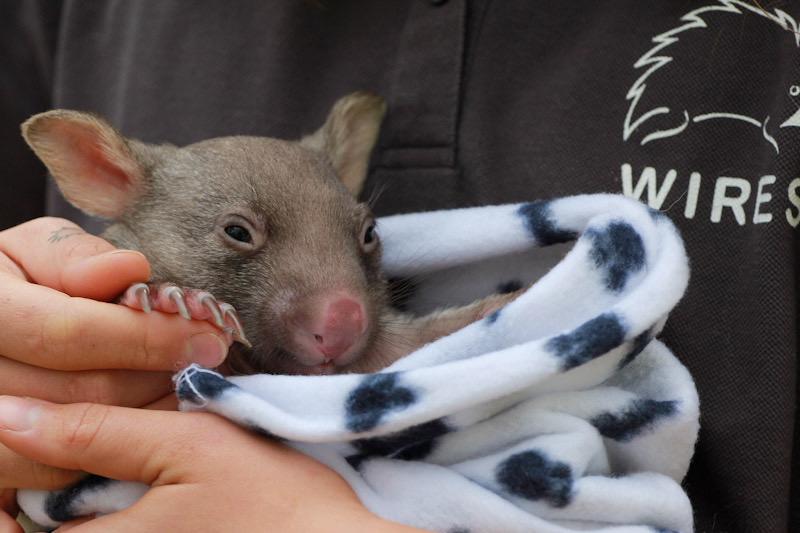A disease known as sarcoptic mange continues to spark concerns from animal welfare groups, as it is now estimated to be present in 90% of wombat populations1, and causes major suffering of infected animals. To tackle the potentially deadly disease, popular flea and paralysis tick treatment, Bravecto Spot-on for Dogs has been granted a permit (PER90837) by the Australian Pesticides Veterinary Medicine Authority (APVMA) to be used for control of sarcoptic mange in wombats. Ahead of International Wombat Day (22 October), Bravecto, together with WIRES Wildlife Rescue and Pet Circle, have collaborated and are committed to improving the welfare of wombats. During the month of October, $1 from every Bravecto purchase made through Pet Circle will be donated to WIRES Wildlife Rescue to help treat wombats from sarcoptic mange.
Wombats are one of Australia’s most iconic animals that not only contribute to the nation’s culture but also play as a critical role in Australian ecosystems. Wombats are natural digging machines that can dramatically improve soil health by bringing necassary nutrients to the surface and help organic matter and plant seedlings mix into compacted soil through their burrowing actions. Sarcoptic mange is caused by a tiny parasitic mite that burrows into the skin of an animal. This parasitic disease isn’t new with records of sarcoptic mange dating back to over a hundred years. It is one of the most widespread parasitic diseases, reported to affect 150 species of wild mammals globally. This mite can also infect humans, commonly referred to as scabies. The APVMA permit for the use of Bravecto Spot-on for Dogs to control sarcoptic mange in wombats has thankfully provided a breakthrough in treating affected wombats and improving their welfare.
Kristie Newton, Programs Manager at Wildlife Information, Rescue and Education Service (WIRES) comments: “The WIRES Rescue Office has recorded a near tripling of wombat rescues over the past seven years. Nearly 40% of wombat-related calls are for wombats with mange, and this figure is expected to rise this year as awareness surrounding this disease increases. With climate change and habitat loss causing stress to wombat populations, we unfortunately expect the disease to continue to spread.”
Fluralaner, the active ingredient in Bravecto Spot-on for Dogs, effectively controls mange in wombats. Bravecto Spot-on for Dogs has been shown to resolve the skin lesions in a wombat with mange in 1-3 treatments. The use of Bravecto is guided by research showing it is well tolerated and effective to treat to wombats suffering from the disease.2
“Through our partnership with Bravecto, over the past year, we have been able to provide 933 free doses
of Bravecto to 10 external organisations, 999 free doses to WIRES members across 13 branches throughout NSW and 80 free doses to our community mange treaters. We estimate that we have helped treat in excess of 1,000 wombats with Bravecto Spot-on for Dogs,” Kristie explains.
Dr Teagan Lever, Head Veterinarian at Pet Circle comments: “Mange in wombats is a painful, debilitating, and fatal health condition. In my work, I have seen firsthand the devastating effects of mange on my patients. I also adopted a puppy with severe mange as a vet student and she was successfully treated and went on to live a happy, healthy and full life of 12 years as our family pet. When she came into my care, treatments like Bravecto Spot-on for Dogs were not available in Australia. Instead, her treatment involved daily injections for many months. Knowing now that as little as a single dose of Bravecto Spot-on for Dogs can effectively treat and control mange is amazing.”
“When we learned about the great work that Bravecto and WIRES were doing to help combat mange in wombats, we saw an opportunity to help animals in need that we couldn’t pass up. Being a better pet parent doesn’t just mean doing the best for your pet, but also doing what is best for the environment, including our native wildlife. Improving animal welfare, whether it is for pets or native animals is deeply aligned with our mission and values,” Teagan adds.
As the largest wildlife rescue organisation in Australia, WIRES teams of volunteers are out in paddocks and scaling river banks daily fighting the disease.
References:
- WHA Fact sheet: Sarcoptic mange in Australian wildlife: https://static1.squarespace.com/static/5d0991e19ea6e200018bdb37/t/5d1066d97afa9100012a8682/156135 6001140/Sarcoptic-Mange-in-Australian-Wildlife-May-2017-2.0.pdf
- Wilkinson et al. Fluralaner as a novel treatment for sarcoptic mange in the bare-nosed wombat (Vombatus ursinus): safety, pharmacokinetics, efficacy and practicable use. Parasites Vectors (2021) 14:18.
Article supplied by MSD Animal Health




